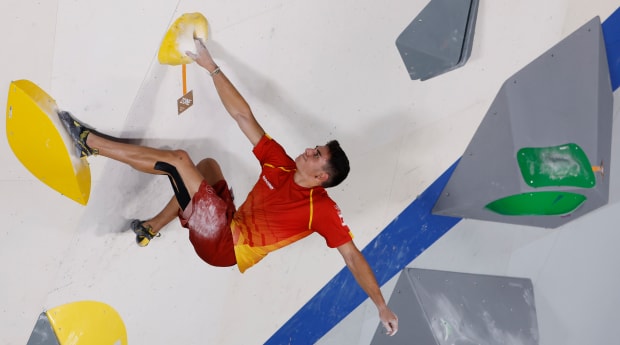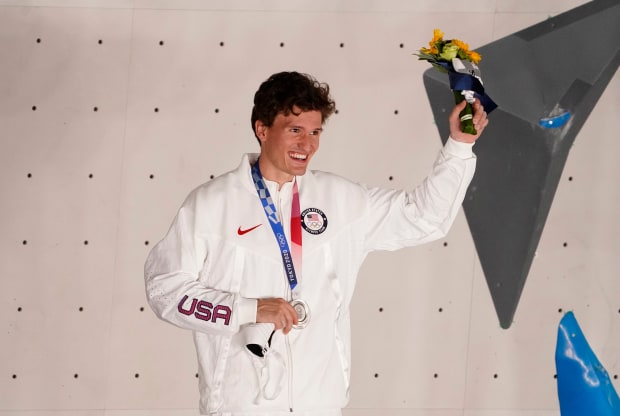Nathaniel Coleman took home the silver for Team USA in the sport's debut at the Games.
The first sport climbing combined final in Olympic history took place against the backdrop of a fuschia sky in Tokyo on Thursday night. The stifling heat and humidity presented an extra challenge to the athletes, but with the help of sizeable amounts of chalk, they broke records and made history nonetheless. Even among climbing giants like the Czech Republic’s Adam Ondra, Japan’s Tomoa Narasaki and Austria’s Jakob Schubert, 18-year old Alberto Ginés López earned the sport’s first gold medal for Spain—a promising Olympic debut for both the young athlete and the sport itself.
Ginés López earned silver at the 2019 Lead Climbing European Championship at just 16 years old, only to place second once more later that month at the 2019 Lead Climbing World Cup. His triumph in Tokyo is yet another step in a meteoric rise that’s sure to continue. Though he faltered in the bouldering discipline with a score of 7, the Spanish climber’s first place and fourth place scores in speed and lead, respectively, more than made up for it. Standing beside him on the podium were American lead specialist Nathaniel Coleman with silver and Schubert with bronze.

Olympic sport climbing is organized in three disciplines—speed climbing, bouldering and lead climbing, each of which presents unique challenges and pulls from different athletic strengths. As an athlete moves through the three events, they are ranked against one another, and the combined final scores are calculated by multiplying an athlete’s three rankings together. At the end of the day, the lowest score gets gold.
Seven athletes vied for that elusive prize at the finals. It would have been eight, had France’s Bassa Mawem not injured his bicep on the lead wall in the qualifying rounds. Mawem, once a favorite in speed, could be seen throughout the finals in the stands, arm in a sling, cheering on his brother, Mickaël, who placed fifth overall.
The night began with speed, which operates in a tournament-style format, as athletes face off against one another to determine who moves to the semifinal and then final rounds. In each individual race, two climbers must scale an identical, standardized wall—which hasn’t changed in decades—in a frenzied test of speed, agility and muscle memory. Each climb takes less than 10 seconds. The most impressive male climbers can do it in six.
The final climb of the speed discipline, between Ginés López and Narasaki, featured an uncharacteristic fall from Narasaki, who slipped a few feet up the wall, giving the Spaniard an undeniable edge of just under two seconds. Ginés López won with a sleek time of 6.42 seconds, well under Narasaki’s 7.82.
Next up was the bouldering round—a slower, more deliberate discipline that is in many ways the polar opposite of the chaotic speed event. Three bouldering routes—called “problems”—are prepared by professionals with the intention of testing specific skills. To complete, or “top,” the climb, an athlete must reach the final hold with both hands. It’s not enough, as it is in speed, to simply touch the top hold—one must hold on to it, demonstrating control over the movement. On each problem, there is a checkpoint hold halfway through the climb known as the “zone.” If a climber reaches the zone, it counts for half credit on the problem and is often used as a tiebreaker.

Problem 1 tested balance and accuracy in movement, requiring the Olympians to balance along a series of sloped surfaces without the benefit of handholds. For the majority of the contenders, this was no trouble. With the closest thing to ease possible within the bouldering discipline, B1 saw five out of seven athletes flash (climbing lingo for finishing the problem on the first attempt). The only climber to miss the top was Ginés López, who specializes in lead and isn’t known for his bouldering skills to begin with.
The real challenge of the night was Problem 2, a route designed to test dynamic coordination. Athletes had to run across two sloped gray blocks, maintaining momentum so as not to lose balance, and then make a dramatic swinging jump to a hold above. The final movement demanded a jump to the top hold—a piece of plastic only large enough for a couple of fingers. Several strong boulderers failed to execute this move with enough control to officially finish the problem, with Schubert, Ginés López, 17-year-old American Colin Duffy, Narasaki and Mawem all falling with one hand on the final hold. Only one athlete—Coleman—topped out on Problem 2. Ondra, touted by many as the greatest climber in the world, didn't even zone.
Designed in the likeness of a Japanese rising sun, Problem 3 featured several gray prisms extending like rays from a small circular yellow hold in the center. Don’t let its elegance fool you—B3, built to test sheer power, stumped every single athlete on the floor. Though each of the seven zoned, none of them were able to top the problem.
Coleman, the only climber to top both of the first two problems, finished the bouldering final in first place, with Mawem and Narasaki trailing behind him in second and third.
With Mawem leading the overall rankings, it all came down to the lead discipline, perhaps the closest descendant of traditional rock climbing. For the lead event, athletes must climb, now roped, as far as they can up a 15 meter wall. Rather than time or tops, lead is judged by height scaled and scored depending on how many moves a climber makes.
Narasaki started off strong with a 33+ (the + indicates a solid attempt at the 34th move). This mark put him in place for the gold, setting the standard to beat for both Mawem and Coleman, the climbers on deck. Though Mawem fell 23 moves in, Coleman narrowly passed Narasaki’s mark by one move, finishing a nail-biting climb with a score of 34+ and the lead. Though Ondra struggled in the speed and bouldering disciplines, he excelled in the lead competition, very nearly topping out the entire wall at 42+ moves. Ginés López similarly outdid his bouldering performance, dropping at 38+, putting him in first place overall based on his combined score from the previous disciplines.
As the final athlete on the lead wall, the entire Olympic podium hung on Schubert’s every move. One by one, he passed each previous athlete’s mark, slowly approaching the magic number—Ondra’s mark of 42+, which would get him on the podium. The crowd and commentators erupted when his fingers closed around the tiny, seemingly inconsequential red hold, and continued on to top the entire wall. In one explosive moment, Schubert had secured a bronze for himself, silver for Coleman, and gold for Ginés López.
More Olympics Coverage:
• I’ve Covered Nine Olympics. Nothing Prepared Me for Seeing My Daughter Win a Medal
• How Simone Biles Came Back to Win the Bronze of Her Life
• Teens Show Unique Culture of Park Skateboarding at Olympics
• Bright Future Ahead for U.S. Swimming After Tokyo Olympics